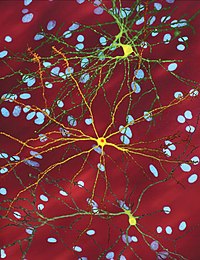
Photo from wikipedia
The glyoxalase gene family consists of six structurally and functionally diverse enzymes with broad roles in metabolism. The common feature that defines this family is based on structural motifs that… Click to show full abstract
The glyoxalase gene family consists of six structurally and functionally diverse enzymes with broad roles in metabolism. The common feature that defines this family is based on structural motifs that coordinate divalent cations which are required for activity. These family members have been implicated in a variety of physiological processes, including amino-acid metabolism (4-hydroxyphenylpyruvate dioxygenase; HPD), primary metabolism (methylmalonyl-CoA epimerase; MCEE), and aldehyde detoxication (glyoxalase 1; GLO1) and therefore have significant associations with disease. A central function of this family is the detoxification of reactive dicarbonyls (e.g., methylglyoxal), which react with cellular nucleophiles, resulting in the modification of lipids, proteins, and DNA. These damaging modifications activate canonical stress responses such as heat shock, unfolded protein, antioxidant, and DNA damage responses. Thus, glyoxalases serve an important role in homeostasis, preventing the pathogenesis of metabolic disease states, including obesity, diabetes, cardiovascular disease, renal failure, and aging. This review presents a thorough overview of the literature surrounding this diverse enzyme class. Although extensive literature exists for some members of this family (e.g., GLO1), little is known about the physiological role of glyoxalase domain-containing protein 4 (GLOD4) and 5 (GLOD5), paving the way for exciting avenues for future research.
Journal Title: Chemical research in toxicology
Year Published: 2022
Link to full text (if available)
Share on Social Media: Sign Up to like & get
recommendations!